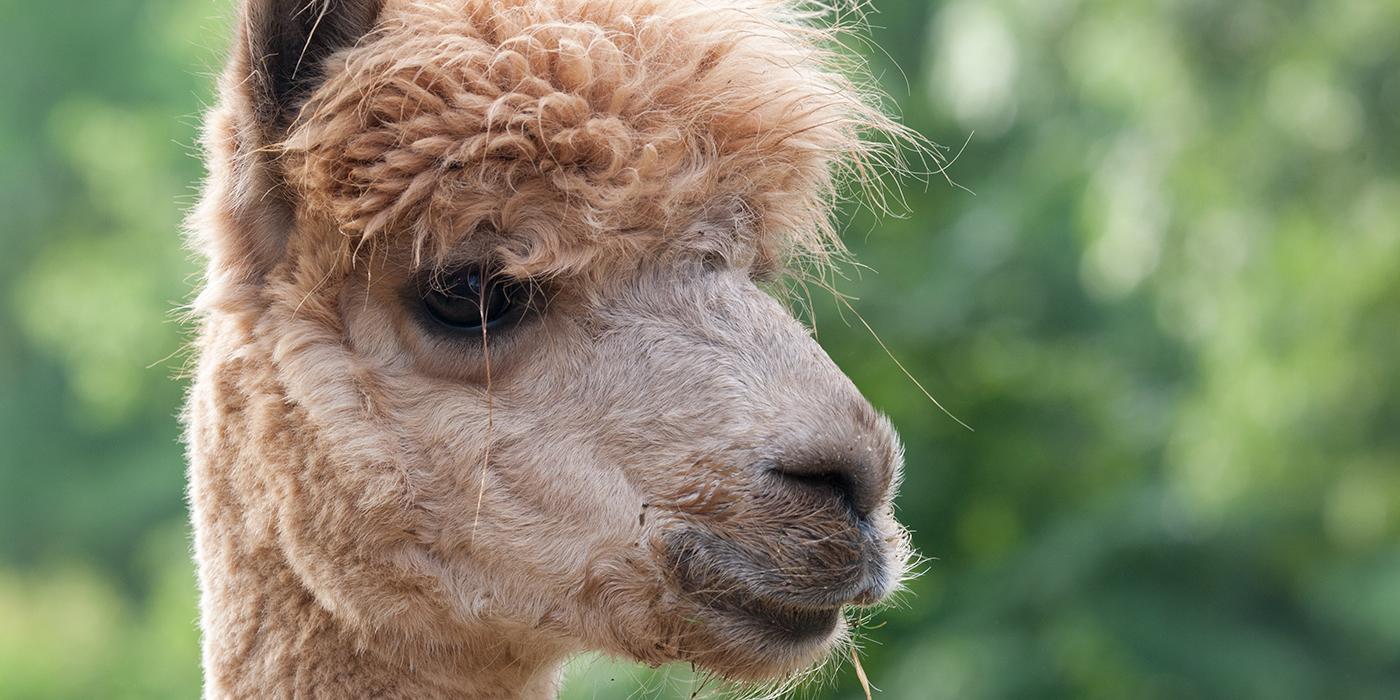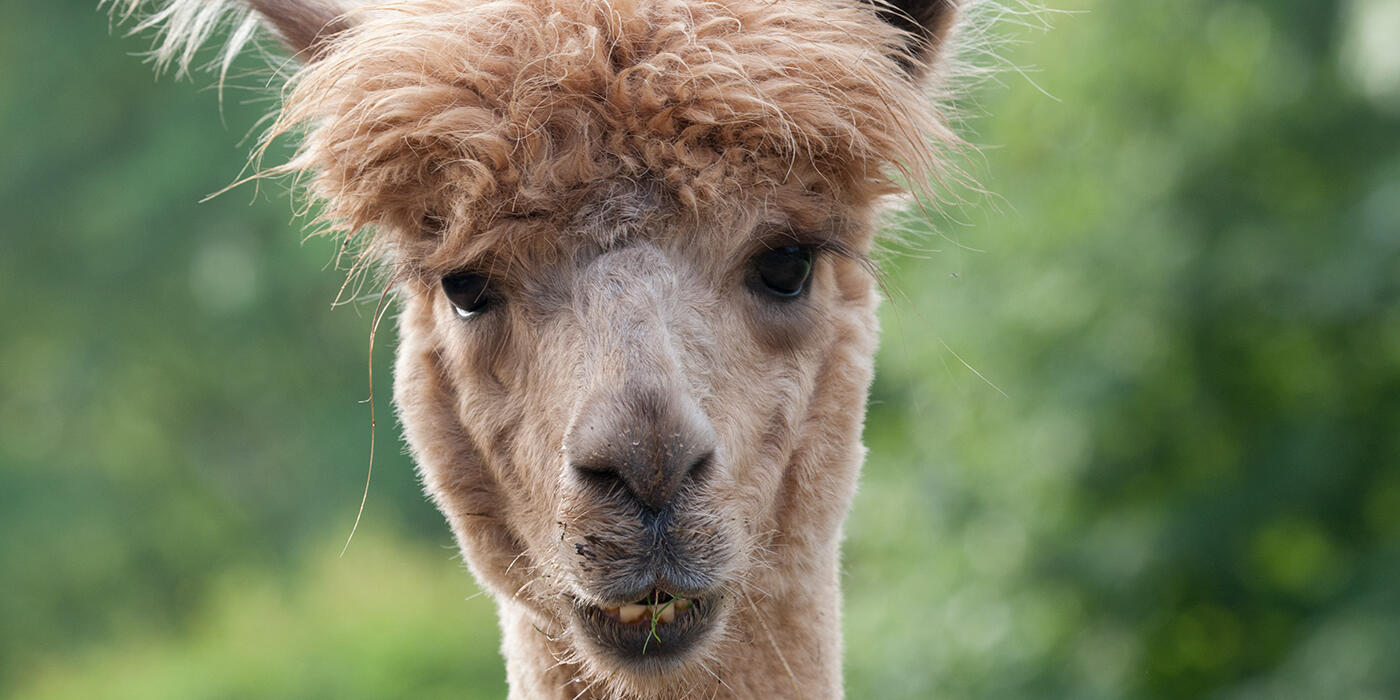The alpaca is a small relative of the camel domesticated by Andean people for its wool. They are slender-bodied animals with long legs and necks, small heads and large, pointed ears. Alpacas are covered in a soft fleece and have soft, padded feet.
Physical Description
Alpacas are slender-bodied animals with long legs and necks, small heads and large, pointed ears. They are covered in a soft fleece that is virtually free of guard hair and occurs in a variety of colors. Alpacas have soft, padded feet that leave even the most delicate grasses and terrain undamaged as they graze. The two types of alpacas are huacaya and suri.
Ninety-five percent of alpacas are huacayas. Their crimpy fiber grows perpendicular to the skin, giving them a wooly appearance. Suris have straight fiber that curls toward the ground, hanging in "dreadlocks." However, because of their finer, less dense coat, the suri is not quite as adept at withstanding severe weather. The suri is rarer with only about 5,000 registered in the United States.
The Smithsonian's National Zoo exhibits huacaya alpaca. Alpacas have no top, front teeth. An adult male alpaca's upper and lower incisors and lower canines develop into fighting teeth or fangs that can be more than 1.2 inches (3 centimeters) long. These teeth do not develop as much in females. Aside from this difference in tooth morphology, sexual dimorphism is minimal in alpacas.
Size
Alpacas are the smallest of the domesticated camelid species. Adult alpacas usually range from 100 to 200 pounds (45 to 90 kilograms). Their head and body length ranges from 47 to 85 inches (1.2 to 2.2 meters), and their tail length ranges from 6 to 10 inches (150 to 220 millimeters). Their shoulder height is typically 32 to 40 inches (0.8 to 1.1 meters).
Huacaya alpaca have a birth weight of between 10 and 17 pounds (4.5 to 7.7 kilograms) and grow to an adult weight of between 100 and 190 pounds (45.3 to 86.1 kilograms). Adults stand 32 to 39 inches (81.2 to 99 centimeters) tall at the shoulder.
Native Habitat
Alpacas are one of the domesticated members of the camel (camelid) family, which also includes llamas, guanacos and vicunas from South America, and the Bactrian and Dromedary camels from Asia and Africa. This family of animals originated on the plains of North America about 10 million years ago. A common ancestor to the South American camelids migrated there about 2.5 million years ago. Two wild species, vicunas and guanacos, still live in the Andes today.
Researchers believe that alpacas were developed through selective breeding that was heavily influenced by the vicuna more than 6,000 years ago. Alpacas and wild vicunas are similar in size, fiber and dentition (teeth). Of all the animals found in the Americas prior to European colonization, llamas and their alpaca cousins had the most influence. Like the buffalo of the Great Plains, both species were a source of meat, fuel and hides.
But unlike buffalo, alpacas and llamas were fully domesticated animals, created centuries before the Incas by Andean people who bred wild forms of South American camelids and clearly appreciated the myriad of benefits woven alpaca fiber offered against the harsh environment in which they lived.
As in ancient days, alpacas are important to Andean herders, providing luxury fiber and meat. Their compact size contributes to easy management and to desirability as a companion animal. Alpacas easily learn to lead, jump in and out of vehicles, cush (sit down) and obey other simple commands. Alpacas are shorn for their valuable fleeces. Males produce approximately 8 pounds and females about 5 pounds of easily marketable fiber from their coats per year.
Alpacas exhibit a variety of natural colors, with approximately 22 basic fiber colors and many variations and blends. Alpaca fiber has a cellular structure similar to hair and is more resilient and much stronger than Merino sheep wool. It is highly sought after in Britain, Europe and Japan.
Communication
Alpacas express themselves with a soft hum, other vocalizations and body language, such as neck posturing, ear and tail positioning, and head tilting. They have excellent eyesight and hearing, and will alert the herd and their human keepers of perceived danger with a staccato alarm call. Alpacas rarely spit at people unless frightened or abused, but will use this form of communication with each other to register a complaint.
Food/Eating Habits
Alpacas are strict grazers. In their native South America, domesticated herds feed on grasses from the mountainsides and valleys of the Andes. For thousands of years, alpacas have lived where grass grows sparsely, and they require much less food than most animals their size. In human care, alpacas usually feed on a combination of fresh grass and low-protein hay. The Zoo's huacaya alpaca are fed mixed grass and herbivore feed.
Social Structure
Alpacas are social herd animals, and their only defense is flight. As they feel safest in numbers and have such strong herding instincts, it is best not to have just one alpaca. Alpacas need the companionship of at least one other alpaca to thrive.
Reproduction and Development
Male alpacas reach sexual maturity when they are about 2 1/2 years old. Females are first bred at 16 to 20 months old. Alpacas are induced ovulators. They have no heat cycles and can breed at any time of the year. This means it takes the physical act of breeding to induce ovulation, making artificial insemination unfeasible.
Responsible breeders consider the weather and pasture conditions very carefully when planning their birthing schedules. An average gestation of 335 days (or about 11.5 months) produces a single baby (cria), which is usually delivered from a standing position during daylight hours. Crias are unusually large for the size of alpaca mothers that average between 120 and 140 pounds (54.4 to 63.5 kilograms).
Mothers often give birth to babies weighing 16 to 22 pounds (7.2 to 10 kilograms). Newborn alpaca are not just large, they also grow rapidly. Mothers need plenty of good nutrition to support a growing cria that will usually weigh more than 100 pounds by the time it is a year old. Crias are generally weaned when they are 6 months old.
Help this Species
Meet the Animals
The Zoo’s two older male alpacas are named Orion and Cirrus. They were joined in 2025 by a pair of young males named Coffee Cup and Rainstorm.
All alpacas grow a thick wool coat that helps keep them warm in their native mountain habitat. Orion’s coat is beige, Cirrus’ coat is white, Coffee Cup's coat is lighter brown and Rainstorm has darker brown coloring on his snout and tips of his ears.
Once a year, typically in April, Kids’ Farm keepers will sheer the alpacas as a special animal demonstration.
Smithsonian's National Zoo and Conservation Biology Institute. (n.d.). Alpaca. Retrieved January 13, 2026, from https://nationalzoo.si.edu/animals/alpaca
Animal News







